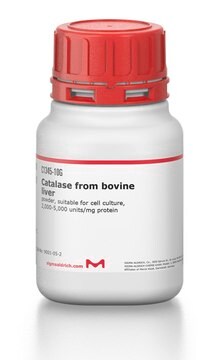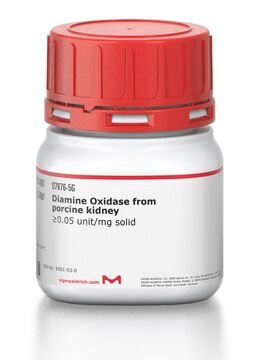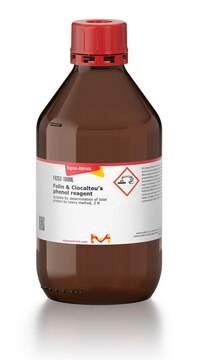P1016
Phenylalanine Ammonia-Lyase from Rhodotorula glutinis
Grade I, buffered aqueous glycerol solution, 0.8-2.0 units/mg protein
Synonym(s):
L-Phenylalanine ammonia-lyase, Phenylalanine Deaminase from Rhodotorula glutinis
Sign Into View Organizational & Contract Pricing
All Photos(1)
About This Item
CAS Number:
MDL number:
UNSPSC Code:
12352204
NACRES:
NA.54
Recommended Products
biological source
fungus (Rhodotorula glutinis)
Quality Level
type
Grade I
form
buffered aqueous glycerol solution
specific activity
0.8-2.0 units/mg protein
shipped in
wet ice
storage temp.
−20°C
Looking for similar products? Visit Product Comparison Guide
Application
Phenylalanine ammonia-lyase has been used in a study to assess the effect of heat treatment on lignification of postharvest bamboo shoots. It has also been used in a study to investigate the effect of light on gene expression and podophyllotoxin biosynthesis in Linum album cell culture.
Biochem/physiol Actions
Phenylalanine Ammonia-Lyase from Rhodotorula glutinis can be cleaved and inactivated by the proteases chymotrypsin, subtilisin, and trypsin.
Unit Definition
One unit will deaminate 1.0 μmole of L-phenylalanine to trans-cinnamate and NH3 per min at pH 8.5 at 30 °C.
Physical form
Solution in 60% glycerol, 3 mM Tris-HCl, pH 7.5, containing up to 0.5 M (NH4)2SO4
Analysis Note
Protein determined by biuret
inhibitor
Product No.
Description
Pricing
Storage Class Code
10 - Combustible liquids
WGK
WGK 2
Flash Point(F)
Not applicable
Flash Point(C)
Not applicable
Choose from one of the most recent versions:
Already Own This Product?
Find documentation for the products that you have recently purchased in the Document Library.
Zisheng Luo et al.
Food chemistry, 135(4), 2182-2187 (2012-09-18)
In order to evaluate the effects of heat treatment on the quality of postharvest bamboo shoots, the firmness, disease incidence, respiration and ethylene production, ACC synthase (ACS) and ACC oxidase (ACO) activities, lignin and cellulose contents, and the activities of
Reid
Applied and environmental microbiology, 64(6), 2117-2125 (1998-06-03)
The fungus Trametes versicolor can delignify and brighten kraft pulps. To better understand the mechanism of this biological bleaching and the by-products formed, I traced the transformation of pulp lignin during treatment with the fungus. Hardwood and softwood kraft pulps
Ronald D Hatfield et al.
Planta, 229(6), 1253-1267 (2009-03-17)
Grasses are a predominant source of nutritional energy for livestock systems around the world. Grasses with high lignin content have lower energy conversion efficiencies for production of bioenergy either in the form of ethanol or to milk and meat through
The effect of light on gene expression and podophyllotoxin biosynthesis in Linum album cell culture.
Morteza Yousefzadi et al.
Plant physiology and biochemistry : PPB, 56, 41-46 (2012-05-15)
Podophyllotoxin (PTOX) is a naturally occurring phenolic compound isolated as an active anti-tumor agent. The stimulatory influence of light on the formation of phenolic compounds has been reported, but the molecular mechanism underlying the effect of light on the expression
H J Gilbert et al.
The Biochemical journal, 199(3), 715-723 (1981-12-01)
Phenylalanine ammonia-lyase (EC 4.3.1.5) of the yeast Rhodotorula glutinis was rapidly inactivated by duodenal juice. It was susceptible to chymotrypsin and subtilisin and to a lesser extent trypsin. Initial proteolysis of the enzyme by chymotrypsin and trypsin resulted in cleavage
Our team of scientists has experience in all areas of research including Life Science, Material Science, Chemical Synthesis, Chromatography, Analytical and many others.
Contact Technical Service








